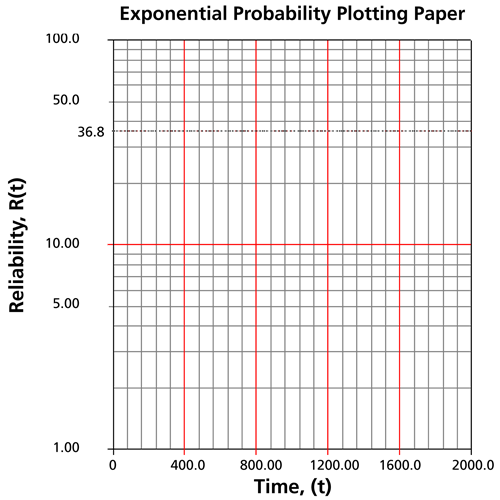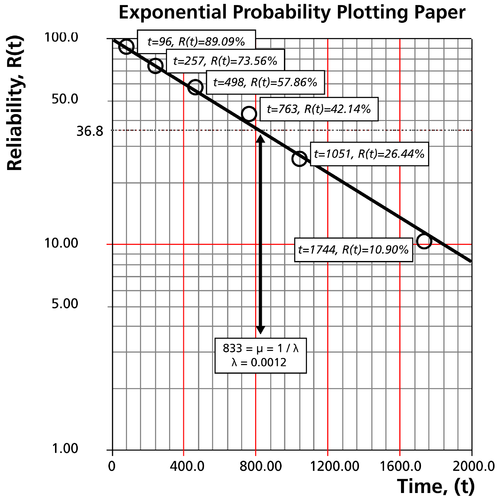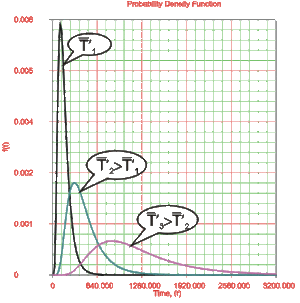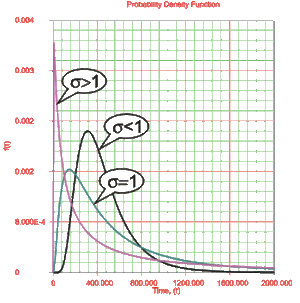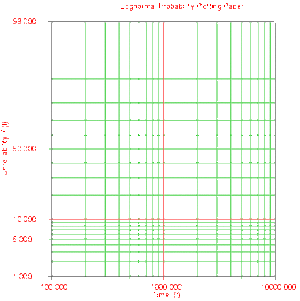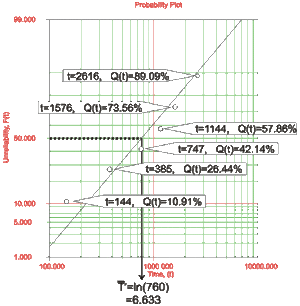Distributions Used in Accelerated Testing
Life Distributions
In this section we will briefly present three lifetime distributions commonly used in accelerated
life test analysis, namely the 1-parameter exponential, the 2-parameter Weibull and the lognormal
distributions. Readers who are interested in a more rigorous overview or in different forms of
these and other life distributions can refer to ReliaSoft's Life Data Analysis Reference, Chapters 6-10 [31].
Life Distributions
In this section we will briefly present three lifetime distributions commonly used in accelerated
life test analysis, namely the 1-parameter exponential, the 2-parameter Weibull and the lognormal
distributions. Readers who are interested in a more rigorous overview or in different forms of
these and other life distributions can refer to ReliaSoft's Life Data Analysis Reference, Chapters 6-10 [31].
Template loop detected: Template:Alta exponential distribution
Parameter Estimation
The parameter of the exponential distribution can be estimated graphically on probability plotting paper or analytically using either least squares or maximum likelihood. (Parameter estimation methods are presented in detail in Appendix B.)
Let's assume six identical units are reliability tested at the same application and operation
stress levels. All of these units fail during the test after operating for the following times (in hours): 96, 257, 498, 763, 1051 and 1744.
The steps for using the probability plotting method to determine the parameters of the exponential pdf representing the data are as follows:
Rank the times-to-failure in ascending order as shown next.
Obtain their median rank plotting positions. Median rank positions are used instead of other ranking methods because median ranks are at a specific confidence level (50%).
The times-to-failure, with their corresponding median ranks, are shown next:
On an exponential probability paper, plot the times on the x-axis and their corresponding rank value on the y-axis. The next figure displays an example of an exponential probability paper. The paper is simply a log-linear paper.
Draw the best possible straight line that goes through the [math]\displaystyle{ t=0\,\! }[/math] and [math]\displaystyle{ (t)=100%\,\! }[/math] point and through the plotted points (as shown in the plot below).
At the [math]\displaystyle{ Q(t)=63.2%\,\! }[/math] or [math]\displaystyle{ R(t)=36.8%\,\! }[/math] ordinate point, draw a straight horizontal line until this line intersects the fitted straight line. Draw a vertical line through this intersection until it crosses the abscissa. The value at the intersection of the abscissa is the estimate of the mean. For this case, [math]\displaystyle{ \widehat{\mu }=833\,\! }[/math] hours which means that [math]\displaystyle{ \lambda =\tfrac{1}{\mu }=0.0012\,\! }[/math] (This is always at 63.2% because [math]\displaystyle{ (T)=1-{{e}^{-\tfrac{\mu }{\mu }}}=1-{{e}^{-1}}=0.632=63.2%)\,\! }[/math].
Now any reliability value for any mission time [math]\displaystyle{ t\,\! }[/math] can be obtained. For example, the reliability for a mission of 15 hours, or any other time, can now be obtained either from the plot or analytically.
To obtain the value from the plot, draw a vertical line from the abscissa, at [math]\displaystyle{ t=15\,\! }[/math] hours, to the fitted line. Draw a horizontal line from this intersection to the ordinate and read [math]\displaystyle{ R(t)\,\! }[/math]. In this case, [math]\displaystyle{ R(t=15)=98.15%\,\! }[/math]. This can also be obtained analytically, from the exponential reliability function.
Template loop detected: Template:Alta weibull distribution
The Lognormal Distribution
The lognormal distribution is commonly used for general reliability analysis, cycles-to-failure in fatigue, material strengths and loading variables in probabilistic design. A random variable is lognormally distributed if the logarithm of the random variable is normally distributed. Since the logarithms of a lognormally distributed random variable are normally distributed, the lognormal distribution is given by:
- [math]\displaystyle{ f({T}')=\frac{1}{{{\sigma }_{{{T}'}}}\sqrt{2\pi }}{{e}^{-\tfrac{1}{2}{{\left( \tfrac{{T}'-\bar{{T}'}}{{{\sigma }_{{{T}'}}}} \right)}^{2}}}} }[/math]
- where:
- • [math]\displaystyle{ {T}'=\ln T }[/math] , and where the [math]\displaystyle{ T }[/math] s are the times-to-failure.
- • [math]\displaystyle{ \bar{{T}'}= }[/math] mean of the natural logarithms of the times to failure.
- • [math]\displaystyle{ {{\sigma }_{{{T}'}}}= }[/math] standard deviation of the natural logarithms of the times to failure.
The lognormal [math]\displaystyle{ pdf }[/math] can be obtained, realizing that for equal probabilities under the normal and lognormal [math]\displaystyle{ pdf }[/math] s incremental areas should also be equal, or:
- [math]\displaystyle{ f(T)dT=f({T}')d{T}' }[/math]
Taking the derivative yields:
- [math]\displaystyle{ d{T}'=\frac{dT}{T} }[/math]
Substitution yields:
- [math]\displaystyle{ \begin{align} & f(T)= & \frac{f({T}')}{T} \\ & = & \frac{1}{T\cdot {{\sigma }_{{{T}'}}}\sqrt{2\pi }}{{e}^{-\tfrac{1}{2}{{\left( \tfrac{{T}'-\bar{{T}'}}{{{\sigma }_{{{T}'}}}} \right)}^{2}}}} \end{align} }[/math]
- where:
- [math]\displaystyle{ f(T)\ge 0,T\gt 0,-\infty \lt \bar{{T}'}\lt \infty ,{{\sigma }_{{{T}'}}}\gt 0 }[/math]
Statistical Properties Summary
The Mean or MTTF
- • The mean of the lognormal distribution, [math]\displaystyle{ \bar{T} }[/math] , is given by:
- [math]\displaystyle{ \bar{T}={{e}^{\bar{{T}'}+\tfrac{1}{2}\sigma _{{{T}'}}^{2}}} }[/math]
- • The mean of the natural logarithms of the times-to-failure, [math]\displaystyle{ {{\bar{T}}^{^{\prime }}} }[/math] , in terms of [math]\displaystyle{ \bar{T} }[/math] and [math]\displaystyle{ {{\sigma }_{T}} }[/math] is given by:
- [math]\displaystyle{ {{\bar{T}}^{\prime }}=\ln \left( {\bar{T}} \right)-\frac{1}{2}\ln \left( \frac{\sigma _{T}^{2}}{{{{\bar{T}}}^{2}}}+1 \right) }[/math]
The Standard Deviation
- • The standard deviation of the lognormal distribution, [math]\displaystyle{ {{\sigma }_{T}} }[/math] , is given by:
- [math]\displaystyle{ {{\sigma }_{T}}=\sqrt{\left( {{e}^{2\bar{{T}'}+\sigma _{{{T}'}}^{2}}} \right)\left( {{e}^{\sigma _{{{T}'}}^{2}}}-1 \right)} }[/math]
- • The standard deviation of the natural logarithms of the times-to-failure, [math]\displaystyle{ {{\sigma }_{{{T}'}}} }[/math] , in terms of [math]\displaystyle{ \bar{T} }[/math] and [math]\displaystyle{ {{\sigma }_{T}} }[/math] is given by:
- [math]\displaystyle{ {{\sigma }_{{{T}'}}}=\sqrt{\ln \left( \frac{\sigma _{T}^{2}}{{{{\bar{T}}}^{2}}}+1 \right)} }[/math]
The Median
- • The median of the lognormal distribution is given by:
- [math]\displaystyle{ \breve{T}={{e}^{{{\bar{T}}^{\prime }}}} }[/math]
The Mode
- • The mode of the lognormal distribution is given by:
- [math]\displaystyle{ \tilde{T}={{e}^{{{\bar{T}}^{\prime }}-\sigma _{{{T}'}}^{2}}} }[/math]
Reliability Function
For the lognormal distribution, the reliability for a mission of time [math]\displaystyle{ T }[/math] , starting at age 0, is given by:
- [math]\displaystyle{ R(T)=\mathop{}_{T}^{\infty }f(t)dt }[/math]
- or:
- [math]\displaystyle{ R(T)=\mathop{}_{{{T}^{^{\prime }}}}^{\infty }\frac{1}{{{\sigma }_{{{T}'}}}\sqrt{2\pi }}{{e}^{-\tfrac{1}{2}{{\left( \tfrac{t-\overline{{{T}'}}}{{{\sigma }_{{{T}'}}}} \right)}^{2}}}}dt }[/math]
There is no closed form solution for the lognormal reliability function. Solutions can be obtained via the use of standard normal tables.
Lognormal Failure Rate
The lognormal failure rate is given by:
- [math]\displaystyle{ \lambda (T)=\frac{f(T)}{R(T)}=\frac{\tfrac{1}{{T}'{{\sigma }_{{{T}'}}}\sqrt{2\pi }}{{e}^{-\tfrac{1}{2}{{(\tfrac{{T}'-\overline{{{T}'}}}{{{\sigma }_{{{T}'}}}})}^{2}}}}}{\mathop{}_{{{T}'}}^{\infty }\tfrac{1}{{{\sigma }_{{{T}'}}}\sqrt{2\pi }}{{e}^{-\tfrac{1}{2}{{(\tfrac{t-\overline{{{T}'}}}{{{\sigma }_{{{T}'}}}})}^{2}}}}dt} }[/math]
Characteristics
- • The lognormal distribution is a distribution skewed to the right.
- • The [math]\displaystyle{ pdf }[/math] starts at zero, increases to its mode, and decreases thereafter.
The characteristics of the lognormal distribution can be exemplified by examining the two parameters, the log-mean, [math]\displaystyle{ ({{\overline{T}}^{\prime }}), }[/math] and the log-std, [math]\displaystyle{ ({{\sigma }_{{{T}'}}}), }[/math] and the effect they have on the [math]\displaystyle{ pdf }[/math] .
Looking at the Log-Mean [math]\displaystyle{ ({{\overline{T}}^{\prime }}) }[/math]
- • The parameter, [math]\displaystyle{ \bar{{T}'} }[/math] , or the log-mean life, or the [math]\displaystyle{ MTT{F}' }[/math] in terms of the logarithm of the [math]\displaystyle{ {T}'s }[/math] is also the scale parameter, and is a unitless number.
- • For the same [math]\displaystyle{ {{\sigma }_{{{T}'}}} }[/math] the [math]\displaystyle{ pdf }[/math] 's skewness increases as [math]\displaystyle{ \bar{{T}'} }[/math] increases.
Looking at the Log-STD [math]\displaystyle{ ({{\sigma }_{{{T}'}}}) }[/math]
- • The parameter [math]\displaystyle{ {{\sigma }_{{{T}'}}} }[/math] , or the standard deviation of the [math]\displaystyle{ {T}'s }[/math] in terms of their logarithm or of their [math]\displaystyle{ {T}' }[/math] , is also the shape parameter, and not the scale parameter as in the normal [math]\displaystyle{ pdf }[/math] . It is a unitless number and assumes only positive values.
- • The degree of skewness increases as [math]\displaystyle{ {{\sigma }_{{{T}'}}} }[/math] increases, for a given [math]\displaystyle{ \bar{{T}'} }[/math] .
- • For [math]\displaystyle{ {{\sigma }_{{{T}'}}} }[/math] values significantly greater than 1, the [math]\displaystyle{ pdf }[/math] rises very sharply in the beginning (i.e. for very small values of [math]\displaystyle{ T }[/math] near zero), and essentially follows the ordinate axis, peaks out early, and then decreases sharply like an exponential [math]\displaystyle{ pdf }[/math] or a Weibull [math]\displaystyle{ pdf }[/math] with [math]\displaystyle{ 0\lt \beta \lt 1 }[/math] .
Parameter Estimation
The estimate of the parameters of the lognormal distribution can be found graphically on probability plotting paper or analytically using either least squares or maximum likelihood. (Parameter estimation methods are presented in detail in Appendix B.)
Probability Plotting
One method of calculating the parameter of the lognormal distribution is by using probability plotting. To better illustrate this procedure, consider the following example.
Example 5
Let's assume six identical units are being reliability tested at the same application and operation stress levels. All of these units fail during the test after operating the following times (in hours), [math]\displaystyle{ {{T}_{i}} }[/math] : 144, 385, 747, 1,144, 1,576 and 2,616.
The steps for determining the parameters of the lognormal [math]\displaystyle{ pdf }[/math] representing the data, using probability plotting, are as follows:
- • Rank the times-to-failure in ascending order as shown next.
- • Obtain their median rank plotting positions. The times-to-failure, with their corresponding median ranks, are shown next:
- • On a lognormal probability paper, plot the times and their corresponding rank value. Fig. 16 displays an example of a lognormal probability paper. The paper is simply a log-log paper. (The solution is given in Fig. 17.)
- • Draw the best possible straight line that goes through the [math]\displaystyle{ t=0 }[/math]
and [math]\displaystyle{ R(t)=100% }[/math] point and through these points (as shown in Fig. 17).
- • At the [math]\displaystyle{ Q(t)=50% }[/math] ordinate point, draw a straight horizontal line until this line intersects the fitted straight line. Draw a vertical line through this intersection until it crosses the abscissa. The value at the intersection of the abscissa is the estimate of the median. For this case, [math]\displaystyle{ \breve{T}=760 }[/math] hr which means that [math]\displaystyle{ {{\bar{T}}^{\prime }}=\ln(\breve{T})=6.633 }[/math](see Eqn. Median).
- [math]\displaystyle{ }[/math]
- • The standard deviation, [math]\displaystyle{ {{\sigma }_{{{T}'}}}, }[/math] can be found using the following equation:
- [math]\displaystyle{ \begin{align} & {{\sigma }_{{{T}'}}}= & \frac{\ln \left[ T(Q=97.7%) \right]-\ln \left[ T(Q=2.3%) \right]}{4} \\ & = & \frac{\ln (5100)-\ln (120)}{4} \\ & = & 0.937376 \end{align} }[/math]
Now any reliability value for any mission time [math]\displaystyle{ t }[/math] can be obtained. For example, the reliability for a mission of 200 hr, or any other time, can now be obtained either from the plot or analytically.
To obtain the value from the plot, draw a vertical line from the abscissa, at [math]\displaystyle{ t=200 }[/math] hr, to the fitted line. Draw a horizontal line from this intersection to the ordinate and read [math]\displaystyle{ Q(t) }[/math] . In this case, [math]\displaystyle{ R(t=200)=1-Q(t=200)=92% }[/math] . This can also be obtained analytically, from the lognormal reliability function. However, standard normal tables (or the Quick Statistical Reference in ALTA) must be used.
MLE Parameter Estimation
The parameters of the lognormal distribution can also be estimated using Maximum Likelihood Estimation (MLE). This general log-likelihood function is:
- [math]\displaystyle{ \begin{align} & \ln (L)= & \Lambda =\underset{i=1}{\overset{{{F}_{e}}}{\mathop \sum }}\,{{N}_{i}}\ln \left[ \frac{1}{{{\sigma }_{{{T}'}}}{{T}_{i}}}\phi \left( \frac{\ln \left( {{T}_{i}} \right)-{\mu }'}{{{\sigma }_{{{T}'}}}} \right) \right] \\ & & \text{ }+\underset{i=1}{\overset{S}{\mathop \sum }}\,N_{i}^{\prime }\ln \left[ 1-\Phi \left( \frac{\ln \left( T_{i}^{\prime } \right)-{\mu }'}{{{\sigma }_{{{T}'}}}} \right) \right]+\overset{FI}{\mathop{\underset{i=1}{\mathop{\underset{}{\overset{}{\mathop \sum }}\,}}\,}}\,N_{i}^{\prime \prime }\ln [\Phi (z_{Ri}^{\prime \prime })-\Phi (z_{Li}^{\prime \prime })] \end{align} }[/math]
- where:
- [math]\displaystyle{ z_{Li}^{\prime \prime }=\frac{\ln T_{Li}^{\prime \prime }-{\mu }'}{\sigma _{T}^{\prime }} }[/math]
- [math]\displaystyle{ z_{Ri}^{\prime \prime }=\frac{\ln T_{Ri}^{\prime \prime }-{\mu }'}{\sigma _{T}^{\prime }} }[/math]
- and:
- • [math]\displaystyle{ {{F}_{e}} }[/math] is the number of groups of times-to-failure data points.
- • [math]\displaystyle{ {{N}_{i}} }[/math] is the number of times-to-failure in the [math]\displaystyle{ {{i}^{th}} }[/math] time-to-failure data group.
- • [math]\displaystyle{ {\mu }' }[/math] is the mean of the natural logarithms of the times-to-failure (unknown a priori, the first of two parameters to be found).
- • [math]\displaystyle{ {{\sigma }_{{{T}'}}} }[/math] is the standard deviation of the natural logarithms of the times-to-failure (unknown a priori, the second of two parameters to be found).
- • [math]\displaystyle{ {{T}_{i}} }[/math] is the time of the [math]\displaystyle{ {{i}^{th}} }[/math] group of time-to-failure data.
- • [math]\displaystyle{ S }[/math] is the number of groups of suspension data points.
- • [math]\displaystyle{ N_{i}^{\prime } }[/math] is the number of suspensions in [math]\displaystyle{ {{i}^{th}} }[/math] group of suspension data points.
- • [math]\displaystyle{ T_{i}^{\prime } }[/math] is the time of the [math]\displaystyle{ {{i}^{th}} }[/math] suspension data group.
- • [math]\displaystyle{ FI }[/math] is the number of interval data groups.
- • [math]\displaystyle{ N_{i}^{\prime \prime } }[/math] is the number of intervals in the i [math]\displaystyle{ ^{th} }[/math] group of data intervals.
- • [math]\displaystyle{ T_{Li}^{\prime \prime } }[/math] is the beginning of the i [math]\displaystyle{ ^{th} }[/math] interval.
- • [math]\displaystyle{ T_{Ri}^{\prime \prime } }[/math] is the ending of the i [math]\displaystyle{ ^{th} }[/math] interval.
The solution will be found by solving for a pair of parameters [math]\displaystyle{ \left( {\mu }',{{\sigma }_{{{T}'}}} \right) }[/math] so that [math]\displaystyle{ \tfrac{\partial \Lambda }{\partial {\mu }'}=0 }[/math] and [math]\displaystyle{ \tfrac{\partial \Lambda }{\partial {{\sigma }_{{{T}'}}}}=0, }[/math] where:
- [math]\displaystyle{ \begin{align} & \frac{\partial \Lambda }{\partial {\mu }'}= & \frac{1}{\sigma _{{{T}'}}^{2}}\underset{i=1}{\overset{{{F}_{e}}}{\mathop \sum }}\,{{N}_{i}}(\ln ({{T}_{i}})-{\mu }') \\ & & +\frac{1}{{{\sigma }_{{{T}'}}}}\underset{i=1}{\overset{S}{\mathop \sum }}\,N_{i}^{\prime }\frac{\phi \left( \tfrac{\ln \left( T_{i}^{\prime } \right)-{\mu }'}{{{\sigma }_{{{T}'}}}} \right)}{1-\Phi \left( \tfrac{\ln \left( T_{i}^{\prime } \right)-{\mu }'}{{{\sigma }_{{{T}'}}}} \right)}\overset{FI}{\mathop{\underset{i=1}{\mathop{-\underset{}{\overset{}{\mathop \sum }}\,}}\,}}\,N_{i}^{\prime \prime }\frac{\varphi (z_{Ri}^{\prime \prime })-\varphi (z_{Li}^{\prime \prime })}{\sigma _{T}^{\prime }(\Phi (z_{Ri}^{\prime \prime })-\Phi (z_{Li}^{\prime \prime }))} \\ & & \\ & \frac{\partial \Lambda }{\partial {{\sigma }_{{{T}'}}}}= & \underset{i=1}{\overset{{{F}_{e}}}{\mathop \sum }}\,{{N}_{i}}\left( \frac{{{\left( \ln ({{T}_{i}})-{\mu }' \right)}^{2}}}{\sigma _{{{T}'}}^{3}}-\frac{1}{{{\sigma }_{{{T}'}}}} \right) \\ & & +\frac{1}{{{\sigma }_{{{T}'}}}}\underset{i=1}{\overset{S}{\mathop \sum }}\,N_{i}^{\prime }\frac{\left( \tfrac{\ln \left( T_{i}^{\prime } \right)-{\mu }'}{{{\sigma }_{{{T}'}}}} \right)\phi \left( \tfrac{\ln \left( T_{i}^{\prime } \right)-{\mu }'}{{{\sigma }_{{{T}'}}}} \right)}{1-\Phi \left( \tfrac{\ln \left( T_{i}^{\prime } \right)-{\mu }'}{{{\sigma }_{{{T}'}}}} \right)}\overset{FI}{\mathop{\underset{i=1}{\mathop{-\underset{}{\overset{}{\mathop \sum }}\,}}\,}}\,N_{i}^{\prime \prime }\frac{z_{Ri}^{\prime \prime }\varphi (z_{Ri}^{\prime \prime })-z_{Li}^{\prime \prime }\varphi (z_{Li}^{\prime \prime })}{\sigma _{T}^{\prime }(\Phi (z_{Ri}^{\prime \prime })-\Phi (z_{Li}^{\prime \prime }))} \end{align} }[/math]
- and:
- [math]\displaystyle{ \phi \left( x \right)=\frac{1}{\sqrt{2\pi }}\cdot {{e}^{-\tfrac{1}{2}{{\left( x \right)}^{2}}}} }[/math]
- [math]\displaystyle{ \Phi (x)=\frac{1}{\sqrt{2\pi }}\mathop{}_{-\infty }^{x}{{e}^{-\tfrac{{{t}^{2}}}{2}}}dx }[/math]
Example 6
Using the same data as in the probability plotting example (Example 5), and assuming a lognormal distribution, estimate the parameters using the MLE method.
Solution
In this example we have non-grouped data without suspensions. Thus, the partials reduce to:
- [math]\displaystyle{ \begin{align} & \frac{\partial \Lambda }{\partial {\mu }'}= & \frac{1}{\sigma _{{{T}'}}^{2}}\cdot \underset{i=1}{\overset{14}{\mathop \sum }}\,\ln ({{T}_{i}})-{\mu }'=0 \\ & \frac{\partial \Lambda }{\partial {{\sigma }_{{{T}'}}}}= & \underset{i=1}{\overset{14}{\mathop \sum }}\,\left( \frac{\ln ({{T}_{i}})-{\mu }'}{\sigma _{{{T}'}}^{3}}-\frac{1}{{{\sigma }_{{{T}'}}}} \right)=0 \end{align} }[/math]
Substituting the values of [math]\displaystyle{ {{T}_{i}} }[/math] and solving the above system simultaneously, we get:
- [math]\displaystyle{ \begin{align} & {{\sigma }_{{{T}'}}}= & 0.9537 \\ & {\mu }'= & 6.6356 \end{align} }[/math]
The mean and standard deviation of the times-to-failure can be estimated using Eqns. (mean) and (sdv):
- [math]\displaystyle{ \overline{T}=\mu =1,200.31\text{ }hr }[/math]
- and:
- [math]\displaystyle{ {{\sigma }_{T}}=1,461.78\text{ }hr }[/math]
| The material on this page is copyrighted. | ©1992-2012. ReliaSoft Corporation. ALL RIGHTS RESERVED. |
[[Category:Acclerated_Testing_Reference]
Parameter Estimation
The parameter of the exponential distribution can be estimated graphically on probability plotting paper or analytically using either least squares or maximum likelihood. (Parameter estimation methods are presented in detail in Appendix B.)
Let's assume six identical units are reliability tested at the same application and operation
stress levels. All of these units fail during the test after operating for the following times (in hours): 96, 257, 498, 763, 1051 and 1744.
The steps for using the probability plotting method to determine the parameters of the exponential pdf representing the data are as follows:
Rank the times-to-failure in ascending order as shown next.
Obtain their median rank plotting positions. Median rank positions are used instead of other ranking methods because median ranks are at a specific confidence level (50%).
The times-to-failure, with their corresponding median ranks, are shown next:
On an exponential probability paper, plot the times on the x-axis and their corresponding rank value on the y-axis. The next figure displays an example of an exponential probability paper. The paper is simply a log-linear paper.
Draw the best possible straight line that goes through the [math]\displaystyle{ t=0\,\! }[/math] and [math]\displaystyle{ (t)=100%\,\! }[/math] point and through the plotted points (as shown in the plot below).
At the [math]\displaystyle{ Q(t)=63.2%\,\! }[/math] or [math]\displaystyle{ R(t)=36.8%\,\! }[/math] ordinate point, draw a straight horizontal line until this line intersects the fitted straight line. Draw a vertical line through this intersection until it crosses the abscissa. The value at the intersection of the abscissa is the estimate of the mean. For this case, [math]\displaystyle{ \widehat{\mu }=833\,\! }[/math] hours which means that [math]\displaystyle{ \lambda =\tfrac{1}{\mu }=0.0012\,\! }[/math] (This is always at 63.2% because [math]\displaystyle{ (T)=1-{{e}^{-\tfrac{\mu }{\mu }}}=1-{{e}^{-1}}=0.632=63.2%)\,\! }[/math].
Now any reliability value for any mission time [math]\displaystyle{ t\,\! }[/math] can be obtained. For example, the reliability for a mission of 15 hours, or any other time, can now be obtained either from the plot or analytically.
To obtain the value from the plot, draw a vertical line from the abscissa, at [math]\displaystyle{ t=15\,\! }[/math] hours, to the fitted line. Draw a horizontal line from this intersection to the ordinate and read [math]\displaystyle{ R(t)\,\! }[/math]. In this case, [math]\displaystyle{ R(t=15)=98.15%\,\! }[/math]. This can also be obtained analytically, from the exponential reliability function.
Life Distributions
In this section we will briefly present three lifetime distributions commonly used in accelerated
life test analysis, namely the 1-parameter exponential, the 2-parameter Weibull and the lognormal
distributions. Readers who are interested in a more rigorous overview or in different forms of
these and other life distributions can refer to ReliaSoft's Life Data Analysis Reference, Chapters 6-10 [31].
Template loop detected: Template:Alta exponential distribution
Parameter Estimation
The parameter of the exponential distribution can be estimated graphically on probability plotting paper or analytically using either least squares or maximum likelihood. (Parameter estimation methods are presented in detail in Appendix B.)
Let's assume six identical units are reliability tested at the same application and operation
stress levels. All of these units fail during the test after operating for the following times (in hours): 96, 257, 498, 763, 1051 and 1744.
The steps for using the probability plotting method to determine the parameters of the exponential pdf representing the data are as follows:
Rank the times-to-failure in ascending order as shown next.
Obtain their median rank plotting positions. Median rank positions are used instead of other ranking methods because median ranks are at a specific confidence level (50%).
The times-to-failure, with their corresponding median ranks, are shown next:
On an exponential probability paper, plot the times on the x-axis and their corresponding rank value on the y-axis. The next figure displays an example of an exponential probability paper. The paper is simply a log-linear paper.
Draw the best possible straight line that goes through the [math]\displaystyle{ t=0\,\! }[/math] and [math]\displaystyle{ (t)=100%\,\! }[/math] point and through the plotted points (as shown in the plot below).
At the [math]\displaystyle{ Q(t)=63.2%\,\! }[/math] or [math]\displaystyle{ R(t)=36.8%\,\! }[/math] ordinate point, draw a straight horizontal line until this line intersects the fitted straight line. Draw a vertical line through this intersection until it crosses the abscissa. The value at the intersection of the abscissa is the estimate of the mean. For this case, [math]\displaystyle{ \widehat{\mu }=833\,\! }[/math] hours which means that [math]\displaystyle{ \lambda =\tfrac{1}{\mu }=0.0012\,\! }[/math] (This is always at 63.2% because [math]\displaystyle{ (T)=1-{{e}^{-\tfrac{\mu }{\mu }}}=1-{{e}^{-1}}=0.632=63.2%)\,\! }[/math].
Now any reliability value for any mission time [math]\displaystyle{ t\,\! }[/math] can be obtained. For example, the reliability for a mission of 15 hours, or any other time, can now be obtained either from the plot or analytically.
To obtain the value from the plot, draw a vertical line from the abscissa, at [math]\displaystyle{ t=15\,\! }[/math] hours, to the fitted line. Draw a horizontal line from this intersection to the ordinate and read [math]\displaystyle{ R(t)\,\! }[/math]. In this case, [math]\displaystyle{ R(t=15)=98.15%\,\! }[/math]. This can also be obtained analytically, from the exponential reliability function.
Template loop detected: Template:Alta weibull distribution
The Lognormal Distribution
The lognormal distribution is commonly used for general reliability analysis, cycles-to-failure in fatigue, material strengths and loading variables in probabilistic design. A random variable is lognormally distributed if the logarithm of the random variable is normally distributed. Since the logarithms of a lognormally distributed random variable are normally distributed, the lognormal distribution is given by:
- [math]\displaystyle{ f({T}')=\frac{1}{{{\sigma }_{{{T}'}}}\sqrt{2\pi }}{{e}^{-\tfrac{1}{2}{{\left( \tfrac{{T}'-\bar{{T}'}}{{{\sigma }_{{{T}'}}}} \right)}^{2}}}} }[/math]
- where:
- • [math]\displaystyle{ {T}'=\ln T }[/math] , and where the [math]\displaystyle{ T }[/math] s are the times-to-failure.
- • [math]\displaystyle{ \bar{{T}'}= }[/math] mean of the natural logarithms of the times to failure.
- • [math]\displaystyle{ {{\sigma }_{{{T}'}}}= }[/math] standard deviation of the natural logarithms of the times to failure.
The lognormal [math]\displaystyle{ pdf }[/math] can be obtained, realizing that for equal probabilities under the normal and lognormal [math]\displaystyle{ pdf }[/math] s incremental areas should also be equal, or:
- [math]\displaystyle{ f(T)dT=f({T}')d{T}' }[/math]
Taking the derivative yields:
- [math]\displaystyle{ d{T}'=\frac{dT}{T} }[/math]
Substitution yields:
- [math]\displaystyle{ \begin{align} & f(T)= & \frac{f({T}')}{T} \\ & = & \frac{1}{T\cdot {{\sigma }_{{{T}'}}}\sqrt{2\pi }}{{e}^{-\tfrac{1}{2}{{\left( \tfrac{{T}'-\bar{{T}'}}{{{\sigma }_{{{T}'}}}} \right)}^{2}}}} \end{align} }[/math]
- where:
- [math]\displaystyle{ f(T)\ge 0,T\gt 0,-\infty \lt \bar{{T}'}\lt \infty ,{{\sigma }_{{{T}'}}}\gt 0 }[/math]
Statistical Properties Summary
The Mean or MTTF
- • The mean of the lognormal distribution, [math]\displaystyle{ \bar{T} }[/math] , is given by:
- [math]\displaystyle{ \bar{T}={{e}^{\bar{{T}'}+\tfrac{1}{2}\sigma _{{{T}'}}^{2}}} }[/math]
- • The mean of the natural logarithms of the times-to-failure, [math]\displaystyle{ {{\bar{T}}^{^{\prime }}} }[/math] , in terms of [math]\displaystyle{ \bar{T} }[/math] and [math]\displaystyle{ {{\sigma }_{T}} }[/math] is given by:
- [math]\displaystyle{ {{\bar{T}}^{\prime }}=\ln \left( {\bar{T}} \right)-\frac{1}{2}\ln \left( \frac{\sigma _{T}^{2}}{{{{\bar{T}}}^{2}}}+1 \right) }[/math]
The Standard Deviation
- • The standard deviation of the lognormal distribution, [math]\displaystyle{ {{\sigma }_{T}} }[/math] , is given by:
- [math]\displaystyle{ {{\sigma }_{T}}=\sqrt{\left( {{e}^{2\bar{{T}'}+\sigma _{{{T}'}}^{2}}} \right)\left( {{e}^{\sigma _{{{T}'}}^{2}}}-1 \right)} }[/math]
- • The standard deviation of the natural logarithms of the times-to-failure, [math]\displaystyle{ {{\sigma }_{{{T}'}}} }[/math] , in terms of [math]\displaystyle{ \bar{T} }[/math] and [math]\displaystyle{ {{\sigma }_{T}} }[/math] is given by:
- [math]\displaystyle{ {{\sigma }_{{{T}'}}}=\sqrt{\ln \left( \frac{\sigma _{T}^{2}}{{{{\bar{T}}}^{2}}}+1 \right)} }[/math]
The Median
- • The median of the lognormal distribution is given by:
- [math]\displaystyle{ \breve{T}={{e}^{{{\bar{T}}^{\prime }}}} }[/math]
The Mode
- • The mode of the lognormal distribution is given by:
- [math]\displaystyle{ \tilde{T}={{e}^{{{\bar{T}}^{\prime }}-\sigma _{{{T}'}}^{2}}} }[/math]
Reliability Function
For the lognormal distribution, the reliability for a mission of time [math]\displaystyle{ T }[/math] , starting at age 0, is given by:
- [math]\displaystyle{ R(T)=\mathop{}_{T}^{\infty }f(t)dt }[/math]
- or:
- [math]\displaystyle{ R(T)=\mathop{}_{{{T}^{^{\prime }}}}^{\infty }\frac{1}{{{\sigma }_{{{T}'}}}\sqrt{2\pi }}{{e}^{-\tfrac{1}{2}{{\left( \tfrac{t-\overline{{{T}'}}}{{{\sigma }_{{{T}'}}}} \right)}^{2}}}}dt }[/math]
There is no closed form solution for the lognormal reliability function. Solutions can be obtained via the use of standard normal tables.
Lognormal Failure Rate
The lognormal failure rate is given by:
- [math]\displaystyle{ \lambda (T)=\frac{f(T)}{R(T)}=\frac{\tfrac{1}{{T}'{{\sigma }_{{{T}'}}}\sqrt{2\pi }}{{e}^{-\tfrac{1}{2}{{(\tfrac{{T}'-\overline{{{T}'}}}{{{\sigma }_{{{T}'}}}})}^{2}}}}}{\mathop{}_{{{T}'}}^{\infty }\tfrac{1}{{{\sigma }_{{{T}'}}}\sqrt{2\pi }}{{e}^{-\tfrac{1}{2}{{(\tfrac{t-\overline{{{T}'}}}{{{\sigma }_{{{T}'}}}})}^{2}}}}dt} }[/math]
Characteristics
- • The lognormal distribution is a distribution skewed to the right.
- • The [math]\displaystyle{ pdf }[/math] starts at zero, increases to its mode, and decreases thereafter.
The characteristics of the lognormal distribution can be exemplified by examining the two parameters, the log-mean, [math]\displaystyle{ ({{\overline{T}}^{\prime }}), }[/math] and the log-std, [math]\displaystyle{ ({{\sigma }_{{{T}'}}}), }[/math] and the effect they have on the [math]\displaystyle{ pdf }[/math] .
Looking at the Log-Mean [math]\displaystyle{ ({{\overline{T}}^{\prime }}) }[/math]
- • The parameter, [math]\displaystyle{ \bar{{T}'} }[/math] , or the log-mean life, or the [math]\displaystyle{ MTT{F}' }[/math] in terms of the logarithm of the [math]\displaystyle{ {T}'s }[/math] is also the scale parameter, and is a unitless number.
- • For the same [math]\displaystyle{ {{\sigma }_{{{T}'}}} }[/math] the [math]\displaystyle{ pdf }[/math] 's skewness increases as [math]\displaystyle{ \bar{{T}'} }[/math] increases.
Looking at the Log-STD [math]\displaystyle{ ({{\sigma }_{{{T}'}}}) }[/math]
- • The parameter [math]\displaystyle{ {{\sigma }_{{{T}'}}} }[/math] , or the standard deviation of the [math]\displaystyle{ {T}'s }[/math] in terms of their logarithm or of their [math]\displaystyle{ {T}' }[/math] , is also the shape parameter, and not the scale parameter as in the normal [math]\displaystyle{ pdf }[/math] . It is a unitless number and assumes only positive values.
- • The degree of skewness increases as [math]\displaystyle{ {{\sigma }_{{{T}'}}} }[/math] increases, for a given [math]\displaystyle{ \bar{{T}'} }[/math] .
- • For [math]\displaystyle{ {{\sigma }_{{{T}'}}} }[/math] values significantly greater than 1, the [math]\displaystyle{ pdf }[/math] rises very sharply in the beginning (i.e. for very small values of [math]\displaystyle{ T }[/math] near zero), and essentially follows the ordinate axis, peaks out early, and then decreases sharply like an exponential [math]\displaystyle{ pdf }[/math] or a Weibull [math]\displaystyle{ pdf }[/math] with [math]\displaystyle{ 0\lt \beta \lt 1 }[/math] .
Parameter Estimation
The estimate of the parameters of the lognormal distribution can be found graphically on probability plotting paper or analytically using either least squares or maximum likelihood. (Parameter estimation methods are presented in detail in Appendix B.)
Probability Plotting
One method of calculating the parameter of the lognormal distribution is by using probability plotting. To better illustrate this procedure, consider the following example.
Example 5
Let's assume six identical units are being reliability tested at the same application and operation stress levels. All of these units fail during the test after operating the following times (in hours), [math]\displaystyle{ {{T}_{i}} }[/math] : 144, 385, 747, 1,144, 1,576 and 2,616.
The steps for determining the parameters of the lognormal [math]\displaystyle{ pdf }[/math] representing the data, using probability plotting, are as follows:
- • Rank the times-to-failure in ascending order as shown next.
- • Obtain their median rank plotting positions. The times-to-failure, with their corresponding median ranks, are shown next:
- • On a lognormal probability paper, plot the times and their corresponding rank value. Fig. 16 displays an example of a lognormal probability paper. The paper is simply a log-log paper. (The solution is given in Fig. 17.)
- • Draw the best possible straight line that goes through the [math]\displaystyle{ t=0 }[/math]
and [math]\displaystyle{ R(t)=100% }[/math] point and through these points (as shown in Fig. 17).
- • At the [math]\displaystyle{ Q(t)=50% }[/math] ordinate point, draw a straight horizontal line until this line intersects the fitted straight line. Draw a vertical line through this intersection until it crosses the abscissa. The value at the intersection of the abscissa is the estimate of the median. For this case, [math]\displaystyle{ \breve{T}=760 }[/math] hr which means that [math]\displaystyle{ {{\bar{T}}^{\prime }}=\ln(\breve{T})=6.633 }[/math](see Eqn. Median).
- [math]\displaystyle{ }[/math]
- • The standard deviation, [math]\displaystyle{ {{\sigma }_{{{T}'}}}, }[/math] can be found using the following equation:
- [math]\displaystyle{ \begin{align} & {{\sigma }_{{{T}'}}}= & \frac{\ln \left[ T(Q=97.7%) \right]-\ln \left[ T(Q=2.3%) \right]}{4} \\ & = & \frac{\ln (5100)-\ln (120)}{4} \\ & = & 0.937376 \end{align} }[/math]
Now any reliability value for any mission time [math]\displaystyle{ t }[/math] can be obtained. For example, the reliability for a mission of 200 hr, or any other time, can now be obtained either from the plot or analytically.
To obtain the value from the plot, draw a vertical line from the abscissa, at [math]\displaystyle{ t=200 }[/math] hr, to the fitted line. Draw a horizontal line from this intersection to the ordinate and read [math]\displaystyle{ Q(t) }[/math] . In this case, [math]\displaystyle{ R(t=200)=1-Q(t=200)=92% }[/math] . This can also be obtained analytically, from the lognormal reliability function. However, standard normal tables (or the Quick Statistical Reference in ALTA) must be used.
MLE Parameter Estimation
The parameters of the lognormal distribution can also be estimated using Maximum Likelihood Estimation (MLE). This general log-likelihood function is:
- [math]\displaystyle{ \begin{align} & \ln (L)= & \Lambda =\underset{i=1}{\overset{{{F}_{e}}}{\mathop \sum }}\,{{N}_{i}}\ln \left[ \frac{1}{{{\sigma }_{{{T}'}}}{{T}_{i}}}\phi \left( \frac{\ln \left( {{T}_{i}} \right)-{\mu }'}{{{\sigma }_{{{T}'}}}} \right) \right] \\ & & \text{ }+\underset{i=1}{\overset{S}{\mathop \sum }}\,N_{i}^{\prime }\ln \left[ 1-\Phi \left( \frac{\ln \left( T_{i}^{\prime } \right)-{\mu }'}{{{\sigma }_{{{T}'}}}} \right) \right]+\overset{FI}{\mathop{\underset{i=1}{\mathop{\underset{}{\overset{}{\mathop \sum }}\,}}\,}}\,N_{i}^{\prime \prime }\ln [\Phi (z_{Ri}^{\prime \prime })-\Phi (z_{Li}^{\prime \prime })] \end{align} }[/math]
- where:
- [math]\displaystyle{ z_{Li}^{\prime \prime }=\frac{\ln T_{Li}^{\prime \prime }-{\mu }'}{\sigma _{T}^{\prime }} }[/math]
- [math]\displaystyle{ z_{Ri}^{\prime \prime }=\frac{\ln T_{Ri}^{\prime \prime }-{\mu }'}{\sigma _{T}^{\prime }} }[/math]
- and:
- • [math]\displaystyle{ {{F}_{e}} }[/math] is the number of groups of times-to-failure data points.
- • [math]\displaystyle{ {{N}_{i}} }[/math] is the number of times-to-failure in the [math]\displaystyle{ {{i}^{th}} }[/math] time-to-failure data group.
- • [math]\displaystyle{ {\mu }' }[/math] is the mean of the natural logarithms of the times-to-failure (unknown a priori, the first of two parameters to be found).
- • [math]\displaystyle{ {{\sigma }_{{{T}'}}} }[/math] is the standard deviation of the natural logarithms of the times-to-failure (unknown a priori, the second of two parameters to be found).
- • [math]\displaystyle{ {{T}_{i}} }[/math] is the time of the [math]\displaystyle{ {{i}^{th}} }[/math] group of time-to-failure data.
- • [math]\displaystyle{ S }[/math] is the number of groups of suspension data points.
- • [math]\displaystyle{ N_{i}^{\prime } }[/math] is the number of suspensions in [math]\displaystyle{ {{i}^{th}} }[/math] group of suspension data points.
- • [math]\displaystyle{ T_{i}^{\prime } }[/math] is the time of the [math]\displaystyle{ {{i}^{th}} }[/math] suspension data group.
- • [math]\displaystyle{ FI }[/math] is the number of interval data groups.
- • [math]\displaystyle{ N_{i}^{\prime \prime } }[/math] is the number of intervals in the i [math]\displaystyle{ ^{th} }[/math] group of data intervals.
- • [math]\displaystyle{ T_{Li}^{\prime \prime } }[/math] is the beginning of the i [math]\displaystyle{ ^{th} }[/math] interval.
- • [math]\displaystyle{ T_{Ri}^{\prime \prime } }[/math] is the ending of the i [math]\displaystyle{ ^{th} }[/math] interval.
The solution will be found by solving for a pair of parameters [math]\displaystyle{ \left( {\mu }',{{\sigma }_{{{T}'}}} \right) }[/math] so that [math]\displaystyle{ \tfrac{\partial \Lambda }{\partial {\mu }'}=0 }[/math] and [math]\displaystyle{ \tfrac{\partial \Lambda }{\partial {{\sigma }_{{{T}'}}}}=0, }[/math] where:
- [math]\displaystyle{ \begin{align} & \frac{\partial \Lambda }{\partial {\mu }'}= & \frac{1}{\sigma _{{{T}'}}^{2}}\underset{i=1}{\overset{{{F}_{e}}}{\mathop \sum }}\,{{N}_{i}}(\ln ({{T}_{i}})-{\mu }') \\ & & +\frac{1}{{{\sigma }_{{{T}'}}}}\underset{i=1}{\overset{S}{\mathop \sum }}\,N_{i}^{\prime }\frac{\phi \left( \tfrac{\ln \left( T_{i}^{\prime } \right)-{\mu }'}{{{\sigma }_{{{T}'}}}} \right)}{1-\Phi \left( \tfrac{\ln \left( T_{i}^{\prime } \right)-{\mu }'}{{{\sigma }_{{{T}'}}}} \right)}\overset{FI}{\mathop{\underset{i=1}{\mathop{-\underset{}{\overset{}{\mathop \sum }}\,}}\,}}\,N_{i}^{\prime \prime }\frac{\varphi (z_{Ri}^{\prime \prime })-\varphi (z_{Li}^{\prime \prime })}{\sigma _{T}^{\prime }(\Phi (z_{Ri}^{\prime \prime })-\Phi (z_{Li}^{\prime \prime }))} \\ & & \\ & \frac{\partial \Lambda }{\partial {{\sigma }_{{{T}'}}}}= & \underset{i=1}{\overset{{{F}_{e}}}{\mathop \sum }}\,{{N}_{i}}\left( \frac{{{\left( \ln ({{T}_{i}})-{\mu }' \right)}^{2}}}{\sigma _{{{T}'}}^{3}}-\frac{1}{{{\sigma }_{{{T}'}}}} \right) \\ & & +\frac{1}{{{\sigma }_{{{T}'}}}}\underset{i=1}{\overset{S}{\mathop \sum }}\,N_{i}^{\prime }\frac{\left( \tfrac{\ln \left( T_{i}^{\prime } \right)-{\mu }'}{{{\sigma }_{{{T}'}}}} \right)\phi \left( \tfrac{\ln \left( T_{i}^{\prime } \right)-{\mu }'}{{{\sigma }_{{{T}'}}}} \right)}{1-\Phi \left( \tfrac{\ln \left( T_{i}^{\prime } \right)-{\mu }'}{{{\sigma }_{{{T}'}}}} \right)}\overset{FI}{\mathop{\underset{i=1}{\mathop{-\underset{}{\overset{}{\mathop \sum }}\,}}\,}}\,N_{i}^{\prime \prime }\frac{z_{Ri}^{\prime \prime }\varphi (z_{Ri}^{\prime \prime })-z_{Li}^{\prime \prime }\varphi (z_{Li}^{\prime \prime })}{\sigma _{T}^{\prime }(\Phi (z_{Ri}^{\prime \prime })-\Phi (z_{Li}^{\prime \prime }))} \end{align} }[/math]
- and:
- [math]\displaystyle{ \phi \left( x \right)=\frac{1}{\sqrt{2\pi }}\cdot {{e}^{-\tfrac{1}{2}{{\left( x \right)}^{2}}}} }[/math]
- [math]\displaystyle{ \Phi (x)=\frac{1}{\sqrt{2\pi }}\mathop{}_{-\infty }^{x}{{e}^{-\tfrac{{{t}^{2}}}{2}}}dx }[/math]
Example 6
Using the same data as in the probability plotting example (Example 5), and assuming a lognormal distribution, estimate the parameters using the MLE method.
Solution
In this example we have non-grouped data without suspensions. Thus, the partials reduce to:
- [math]\displaystyle{ \begin{align} & \frac{\partial \Lambda }{\partial {\mu }'}= & \frac{1}{\sigma _{{{T}'}}^{2}}\cdot \underset{i=1}{\overset{14}{\mathop \sum }}\,\ln ({{T}_{i}})-{\mu }'=0 \\ & \frac{\partial \Lambda }{\partial {{\sigma }_{{{T}'}}}}= & \underset{i=1}{\overset{14}{\mathop \sum }}\,\left( \frac{\ln ({{T}_{i}})-{\mu }'}{\sigma _{{{T}'}}^{3}}-\frac{1}{{{\sigma }_{{{T}'}}}} \right)=0 \end{align} }[/math]
Substituting the values of [math]\displaystyle{ {{T}_{i}} }[/math] and solving the above system simultaneously, we get:
- [math]\displaystyle{ \begin{align} & {{\sigma }_{{{T}'}}}= & 0.9537 \\ & {\mu }'= & 6.6356 \end{align} }[/math]
The mean and standard deviation of the times-to-failure can be estimated using Eqns. (mean) and (sdv):
- [math]\displaystyle{ \overline{T}=\mu =1,200.31\text{ }hr }[/math]
- and:
- [math]\displaystyle{ {{\sigma }_{T}}=1,461.78\text{ }hr }[/math]
| The material on this page is copyrighted. | ©1992-2012. ReliaSoft Corporation. ALL RIGHTS RESERVED. |
[[Category:Acclerated_Testing_Reference]
The Lognormal Distribution
The lognormal distribution is commonly used for general reliability analysis, cycles-to-failure in fatigue, material strengths and loading variables in probabilistic design. A random variable is lognormally distributed if the logarithm of the random variable is normally distributed. Since the logarithms of a lognormally distributed random variable are normally distributed, the lognormal distribution is given by:
- [math]\displaystyle{ f({T}')=\frac{1}{{{\sigma }_{{{T}'}}}\sqrt{2\pi }}{{e}^{-\tfrac{1}{2}{{\left( \tfrac{{T}'-\bar{{T}'}}{{{\sigma }_{{{T}'}}}} \right)}^{2}}}} }[/math]
- where:
- • [math]\displaystyle{ {T}'=\ln T }[/math] , and where the [math]\displaystyle{ T }[/math] s are the times-to-failure.
- • [math]\displaystyle{ \bar{{T}'}= }[/math] mean of the natural logarithms of the times to failure.
- • [math]\displaystyle{ {{\sigma }_{{{T}'}}}= }[/math] standard deviation of the natural logarithms of the times to failure.
The lognormal [math]\displaystyle{ pdf }[/math] can be obtained, realizing that for equal probabilities under the normal and lognormal [math]\displaystyle{ pdf }[/math] s incremental areas should also be equal, or:
- [math]\displaystyle{ f(T)dT=f({T}')d{T}' }[/math]
Taking the derivative yields:
- [math]\displaystyle{ d{T}'=\frac{dT}{T} }[/math]
Substitution yields:
- [math]\displaystyle{ \begin{align} & f(T)= & \frac{f({T}')}{T} \\ & = & \frac{1}{T\cdot {{\sigma }_{{{T}'}}}\sqrt{2\pi }}{{e}^{-\tfrac{1}{2}{{\left( \tfrac{{T}'-\bar{{T}'}}{{{\sigma }_{{{T}'}}}} \right)}^{2}}}} \end{align} }[/math]
- where:
- [math]\displaystyle{ f(T)\ge 0,T\gt 0,-\infty \lt \bar{{T}'}\lt \infty ,{{\sigma }_{{{T}'}}}\gt 0 }[/math]
Statistical Properties Summary
The Mean or MTTF
- • The mean of the lognormal distribution, [math]\displaystyle{ \bar{T} }[/math] , is given by:
- [math]\displaystyle{ \bar{T}={{e}^{\bar{{T}'}+\tfrac{1}{2}\sigma _{{{T}'}}^{2}}} }[/math]
- • The mean of the natural logarithms of the times-to-failure, [math]\displaystyle{ {{\bar{T}}^{^{\prime }}} }[/math] , in terms of [math]\displaystyle{ \bar{T} }[/math] and [math]\displaystyle{ {{\sigma }_{T}} }[/math] is given by:
- [math]\displaystyle{ {{\bar{T}}^{\prime }}=\ln \left( {\bar{T}} \right)-\frac{1}{2}\ln \left( \frac{\sigma _{T}^{2}}{{{{\bar{T}}}^{2}}}+1 \right) }[/math]
The Standard Deviation
- • The standard deviation of the lognormal distribution, [math]\displaystyle{ {{\sigma }_{T}} }[/math] , is given by:
- [math]\displaystyle{ {{\sigma }_{T}}=\sqrt{\left( {{e}^{2\bar{{T}'}+\sigma _{{{T}'}}^{2}}} \right)\left( {{e}^{\sigma _{{{T}'}}^{2}}}-1 \right)} }[/math]
- • The standard deviation of the natural logarithms of the times-to-failure, [math]\displaystyle{ {{\sigma }_{{{T}'}}} }[/math] , in terms of [math]\displaystyle{ \bar{T} }[/math] and [math]\displaystyle{ {{\sigma }_{T}} }[/math] is given by:
- [math]\displaystyle{ {{\sigma }_{{{T}'}}}=\sqrt{\ln \left( \frac{\sigma _{T}^{2}}{{{{\bar{T}}}^{2}}}+1 \right)} }[/math]
The Median
- • The median of the lognormal distribution is given by:
- [math]\displaystyle{ \breve{T}={{e}^{{{\bar{T}}^{\prime }}}} }[/math]
The Mode
- • The mode of the lognormal distribution is given by:
- [math]\displaystyle{ \tilde{T}={{e}^{{{\bar{T}}^{\prime }}-\sigma _{{{T}'}}^{2}}} }[/math]
Reliability Function
For the lognormal distribution, the reliability for a mission of time [math]\displaystyle{ T }[/math] , starting at age 0, is given by:
- [math]\displaystyle{ R(T)=\mathop{}_{T}^{\infty }f(t)dt }[/math]
- or:
- [math]\displaystyle{ R(T)=\mathop{}_{{{T}^{^{\prime }}}}^{\infty }\frac{1}{{{\sigma }_{{{T}'}}}\sqrt{2\pi }}{{e}^{-\tfrac{1}{2}{{\left( \tfrac{t-\overline{{{T}'}}}{{{\sigma }_{{{T}'}}}} \right)}^{2}}}}dt }[/math]
There is no closed form solution for the lognormal reliability function. Solutions can be obtained via the use of standard normal tables.
Lognormal Failure Rate
The lognormal failure rate is given by:
- [math]\displaystyle{ \lambda (T)=\frac{f(T)}{R(T)}=\frac{\tfrac{1}{{T}'{{\sigma }_{{{T}'}}}\sqrt{2\pi }}{{e}^{-\tfrac{1}{2}{{(\tfrac{{T}'-\overline{{{T}'}}}{{{\sigma }_{{{T}'}}}})}^{2}}}}}{\mathop{}_{{{T}'}}^{\infty }\tfrac{1}{{{\sigma }_{{{T}'}}}\sqrt{2\pi }}{{e}^{-\tfrac{1}{2}{{(\tfrac{t-\overline{{{T}'}}}{{{\sigma }_{{{T}'}}}})}^{2}}}}dt} }[/math]
Characteristics
- • The lognormal distribution is a distribution skewed to the right.
- • The [math]\displaystyle{ pdf }[/math] starts at zero, increases to its mode, and decreases thereafter.
The characteristics of the lognormal distribution can be exemplified by examining the two parameters, the log-mean, [math]\displaystyle{ ({{\overline{T}}^{\prime }}), }[/math] and the log-std, [math]\displaystyle{ ({{\sigma }_{{{T}'}}}), }[/math] and the effect they have on the [math]\displaystyle{ pdf }[/math] .
Looking at the Log-Mean [math]\displaystyle{ ({{\overline{T}}^{\prime }}) }[/math]
- • The parameter, [math]\displaystyle{ \bar{{T}'} }[/math] , or the log-mean life, or the [math]\displaystyle{ MTT{F}' }[/math] in terms of the logarithm of the [math]\displaystyle{ {T}'s }[/math] is also the scale parameter, and is a unitless number.
- • For the same [math]\displaystyle{ {{\sigma }_{{{T}'}}} }[/math] the [math]\displaystyle{ pdf }[/math] 's skewness increases as [math]\displaystyle{ \bar{{T}'} }[/math] increases.
Looking at the Log-STD [math]\displaystyle{ ({{\sigma }_{{{T}'}}}) }[/math]
- • The parameter [math]\displaystyle{ {{\sigma }_{{{T}'}}} }[/math] , or the standard deviation of the [math]\displaystyle{ {T}'s }[/math] in terms of their logarithm or of their [math]\displaystyle{ {T}' }[/math] , is also the shape parameter, and not the scale parameter as in the normal [math]\displaystyle{ pdf }[/math] . It is a unitless number and assumes only positive values.
- • The degree of skewness increases as [math]\displaystyle{ {{\sigma }_{{{T}'}}} }[/math] increases, for a given [math]\displaystyle{ \bar{{T}'} }[/math] .
- • For [math]\displaystyle{ {{\sigma }_{{{T}'}}} }[/math] values significantly greater than 1, the [math]\displaystyle{ pdf }[/math] rises very sharply in the beginning (i.e. for very small values of [math]\displaystyle{ T }[/math] near zero), and essentially follows the ordinate axis, peaks out early, and then decreases sharply like an exponential [math]\displaystyle{ pdf }[/math] or a Weibull [math]\displaystyle{ pdf }[/math] with [math]\displaystyle{ 0\lt \beta \lt 1 }[/math] .
Parameter Estimation
The estimate of the parameters of the lognormal distribution can be found graphically on probability plotting paper or analytically using either least squares or maximum likelihood. (Parameter estimation methods are presented in detail in Appendix B.)
Probability Plotting
One method of calculating the parameter of the lognormal distribution is by using probability plotting. To better illustrate this procedure, consider the following example.
Example 5
Let's assume six identical units are being reliability tested at the same application and operation stress levels. All of these units fail during the test after operating the following times (in hours), [math]\displaystyle{ {{T}_{i}} }[/math] : 144, 385, 747, 1,144, 1,576 and 2,616.
The steps for determining the parameters of the lognormal [math]\displaystyle{ pdf }[/math] representing the data, using probability plotting, are as follows:
- • Rank the times-to-failure in ascending order as shown next.
- • Obtain their median rank plotting positions. The times-to-failure, with their corresponding median ranks, are shown next:
- • On a lognormal probability paper, plot the times and their corresponding rank value. Fig. 16 displays an example of a lognormal probability paper. The paper is simply a log-log paper. (The solution is given in Fig. 17.)
- • Draw the best possible straight line that goes through the [math]\displaystyle{ t=0 }[/math]
and [math]\displaystyle{ R(t)=100% }[/math] point and through these points (as shown in Fig. 17).
- • At the [math]\displaystyle{ Q(t)=50% }[/math] ordinate point, draw a straight horizontal line until this line intersects the fitted straight line. Draw a vertical line through this intersection until it crosses the abscissa. The value at the intersection of the abscissa is the estimate of the median. For this case, [math]\displaystyle{ \breve{T}=760 }[/math] hr which means that [math]\displaystyle{ {{\bar{T}}^{\prime }}=\ln(\breve{T})=6.633 }[/math](see Eqn. Median).
- [math]\displaystyle{ }[/math]
- • The standard deviation, [math]\displaystyle{ {{\sigma }_{{{T}'}}}, }[/math] can be found using the following equation:
- [math]\displaystyle{ \begin{align} & {{\sigma }_{{{T}'}}}= & \frac{\ln \left[ T(Q=97.7%) \right]-\ln \left[ T(Q=2.3%) \right]}{4} \\ & = & \frac{\ln (5100)-\ln (120)}{4} \\ & = & 0.937376 \end{align} }[/math]
Now any reliability value for any mission time [math]\displaystyle{ t }[/math] can be obtained. For example, the reliability for a mission of 200 hr, or any other time, can now be obtained either from the plot or analytically.
To obtain the value from the plot, draw a vertical line from the abscissa, at [math]\displaystyle{ t=200 }[/math] hr, to the fitted line. Draw a horizontal line from this intersection to the ordinate and read [math]\displaystyle{ Q(t) }[/math] . In this case, [math]\displaystyle{ R(t=200)=1-Q(t=200)=92% }[/math] . This can also be obtained analytically, from the lognormal reliability function. However, standard normal tables (or the Quick Statistical Reference in ALTA) must be used.
MLE Parameter Estimation
The parameters of the lognormal distribution can also be estimated using Maximum Likelihood Estimation (MLE). This general log-likelihood function is:
- [math]\displaystyle{ \begin{align} & \ln (L)= & \Lambda =\underset{i=1}{\overset{{{F}_{e}}}{\mathop \sum }}\,{{N}_{i}}\ln \left[ \frac{1}{{{\sigma }_{{{T}'}}}{{T}_{i}}}\phi \left( \frac{\ln \left( {{T}_{i}} \right)-{\mu }'}{{{\sigma }_{{{T}'}}}} \right) \right] \\ & & \text{ }+\underset{i=1}{\overset{S}{\mathop \sum }}\,N_{i}^{\prime }\ln \left[ 1-\Phi \left( \frac{\ln \left( T_{i}^{\prime } \right)-{\mu }'}{{{\sigma }_{{{T}'}}}} \right) \right]+\overset{FI}{\mathop{\underset{i=1}{\mathop{\underset{}{\overset{}{\mathop \sum }}\,}}\,}}\,N_{i}^{\prime \prime }\ln [\Phi (z_{Ri}^{\prime \prime })-\Phi (z_{Li}^{\prime \prime })] \end{align} }[/math]
- where:
- [math]\displaystyle{ z_{Li}^{\prime \prime }=\frac{\ln T_{Li}^{\prime \prime }-{\mu }'}{\sigma _{T}^{\prime }} }[/math]
- [math]\displaystyle{ z_{Ri}^{\prime \prime }=\frac{\ln T_{Ri}^{\prime \prime }-{\mu }'}{\sigma _{T}^{\prime }} }[/math]
- and:
- • [math]\displaystyle{ {{F}_{e}} }[/math] is the number of groups of times-to-failure data points.
- • [math]\displaystyle{ {{N}_{i}} }[/math] is the number of times-to-failure in the [math]\displaystyle{ {{i}^{th}} }[/math] time-to-failure data group.
- • [math]\displaystyle{ {\mu }' }[/math] is the mean of the natural logarithms of the times-to-failure (unknown a priori, the first of two parameters to be found).
- • [math]\displaystyle{ {{\sigma }_{{{T}'}}} }[/math] is the standard deviation of the natural logarithms of the times-to-failure (unknown a priori, the second of two parameters to be found).
- • [math]\displaystyle{ {{T}_{i}} }[/math] is the time of the [math]\displaystyle{ {{i}^{th}} }[/math] group of time-to-failure data.
- • [math]\displaystyle{ S }[/math] is the number of groups of suspension data points.
- • [math]\displaystyle{ N_{i}^{\prime } }[/math] is the number of suspensions in [math]\displaystyle{ {{i}^{th}} }[/math] group of suspension data points.
- • [math]\displaystyle{ T_{i}^{\prime } }[/math] is the time of the [math]\displaystyle{ {{i}^{th}} }[/math] suspension data group.
- • [math]\displaystyle{ FI }[/math] is the number of interval data groups.
- • [math]\displaystyle{ N_{i}^{\prime \prime } }[/math] is the number of intervals in the i [math]\displaystyle{ ^{th} }[/math] group of data intervals.
- • [math]\displaystyle{ T_{Li}^{\prime \prime } }[/math] is the beginning of the i [math]\displaystyle{ ^{th} }[/math] interval.
- • [math]\displaystyle{ T_{Ri}^{\prime \prime } }[/math] is the ending of the i [math]\displaystyle{ ^{th} }[/math] interval.
The solution will be found by solving for a pair of parameters [math]\displaystyle{ \left( {\mu }',{{\sigma }_{{{T}'}}} \right) }[/math] so that [math]\displaystyle{ \tfrac{\partial \Lambda }{\partial {\mu }'}=0 }[/math] and [math]\displaystyle{ \tfrac{\partial \Lambda }{\partial {{\sigma }_{{{T}'}}}}=0, }[/math] where:
- [math]\displaystyle{ \begin{align} & \frac{\partial \Lambda }{\partial {\mu }'}= & \frac{1}{\sigma _{{{T}'}}^{2}}\underset{i=1}{\overset{{{F}_{e}}}{\mathop \sum }}\,{{N}_{i}}(\ln ({{T}_{i}})-{\mu }') \\ & & +\frac{1}{{{\sigma }_{{{T}'}}}}\underset{i=1}{\overset{S}{\mathop \sum }}\,N_{i}^{\prime }\frac{\phi \left( \tfrac{\ln \left( T_{i}^{\prime } \right)-{\mu }'}{{{\sigma }_{{{T}'}}}} \right)}{1-\Phi \left( \tfrac{\ln \left( T_{i}^{\prime } \right)-{\mu }'}{{{\sigma }_{{{T}'}}}} \right)}\overset{FI}{\mathop{\underset{i=1}{\mathop{-\underset{}{\overset{}{\mathop \sum }}\,}}\,}}\,N_{i}^{\prime \prime }\frac{\varphi (z_{Ri}^{\prime \prime })-\varphi (z_{Li}^{\prime \prime })}{\sigma _{T}^{\prime }(\Phi (z_{Ri}^{\prime \prime })-\Phi (z_{Li}^{\prime \prime }))} \\ & & \\ & \frac{\partial \Lambda }{\partial {{\sigma }_{{{T}'}}}}= & \underset{i=1}{\overset{{{F}_{e}}}{\mathop \sum }}\,{{N}_{i}}\left( \frac{{{\left( \ln ({{T}_{i}})-{\mu }' \right)}^{2}}}{\sigma _{{{T}'}}^{3}}-\frac{1}{{{\sigma }_{{{T}'}}}} \right) \\ & & +\frac{1}{{{\sigma }_{{{T}'}}}}\underset{i=1}{\overset{S}{\mathop \sum }}\,N_{i}^{\prime }\frac{\left( \tfrac{\ln \left( T_{i}^{\prime } \right)-{\mu }'}{{{\sigma }_{{{T}'}}}} \right)\phi \left( \tfrac{\ln \left( T_{i}^{\prime } \right)-{\mu }'}{{{\sigma }_{{{T}'}}}} \right)}{1-\Phi \left( \tfrac{\ln \left( T_{i}^{\prime } \right)-{\mu }'}{{{\sigma }_{{{T}'}}}} \right)}\overset{FI}{\mathop{\underset{i=1}{\mathop{-\underset{}{\overset{}{\mathop \sum }}\,}}\,}}\,N_{i}^{\prime \prime }\frac{z_{Ri}^{\prime \prime }\varphi (z_{Ri}^{\prime \prime })-z_{Li}^{\prime \prime }\varphi (z_{Li}^{\prime \prime })}{\sigma _{T}^{\prime }(\Phi (z_{Ri}^{\prime \prime })-\Phi (z_{Li}^{\prime \prime }))} \end{align} }[/math]
- and:
- [math]\displaystyle{ \phi \left( x \right)=\frac{1}{\sqrt{2\pi }}\cdot {{e}^{-\tfrac{1}{2}{{\left( x \right)}^{2}}}} }[/math]
- [math]\displaystyle{ \Phi (x)=\frac{1}{\sqrt{2\pi }}\mathop{}_{-\infty }^{x}{{e}^{-\tfrac{{{t}^{2}}}{2}}}dx }[/math]
Example 6
Using the same data as in the probability plotting example (Example 5), and assuming a lognormal distribution, estimate the parameters using the MLE method.
Solution
In this example we have non-grouped data without suspensions. Thus, the partials reduce to:
- [math]\displaystyle{ \begin{align} & \frac{\partial \Lambda }{\partial {\mu }'}= & \frac{1}{\sigma _{{{T}'}}^{2}}\cdot \underset{i=1}{\overset{14}{\mathop \sum }}\,\ln ({{T}_{i}})-{\mu }'=0 \\ & \frac{\partial \Lambda }{\partial {{\sigma }_{{{T}'}}}}= & \underset{i=1}{\overset{14}{\mathop \sum }}\,\left( \frac{\ln ({{T}_{i}})-{\mu }'}{\sigma _{{{T}'}}^{3}}-\frac{1}{{{\sigma }_{{{T}'}}}} \right)=0 \end{align} }[/math]
Substituting the values of [math]\displaystyle{ {{T}_{i}} }[/math] and solving the above system simultaneously, we get:
- [math]\displaystyle{ \begin{align} & {{\sigma }_{{{T}'}}}= & 0.9537 \\ & {\mu }'= & 6.6356 \end{align} }[/math]
The mean and standard deviation of the times-to-failure can be estimated using Eqns. (mean) and (sdv):
- [math]\displaystyle{ \overline{T}=\mu =1,200.31\text{ }hr }[/math]
- and:
- [math]\displaystyle{ {{\sigma }_{T}}=1,461.78\text{ }hr }[/math]
| The material on this page is copyrighted. | ©1992-2012. ReliaSoft Corporation. ALL RIGHTS RESERVED. |
[[Category:Acclerated_Testing_Reference]

